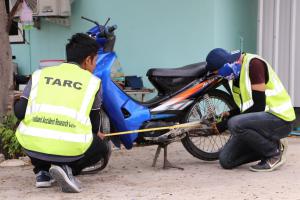Thailand Accident Research Center
ศูนย์วิจัยอุบัติเหตุแห่งประเทศไทย
โครงการสืบสวนสาเหตุการเกิดอุบัติเหตุของรถจักรยานยนต์ในเชิงลึก (Motorcycle Accident Investigation: Year 2016-2020)
During the past decades, motorcycle companies and many research agencies have tried their best to find the contributing factors causing motorcycle crashes, so that different countermeasures can be developed to increase motorcycle users’ safety, either in terms of active safety to prevent or reduce the chance of accidents or passive safety to reduce severity of the accident. During 2016-2020, Asian Honda Co., Ltd., Honda Motor Co., Ltd., and Yamaha Motor Co., Ltd. have supported Thailand Accident Research Center (TARC), Asian Institute of Technology as a leader team collaborating with Chiangmai University, Suranaree University of Technology, Prince of Songkla University, and King Mongkut’s University of Technology Thonburi to conduct the comprehensive survey of motorcycle-related crashes under the project of “Motorcycle Accident Investigation: Micro Study Analysis”. The objective of this project is to conduct the in-depth motorcycle crash investigation to understand the crash patterns and characteristics of motorcycle crashes, and to identify the contributing factors causing motorcycle crashes in Thailand. However, to focus on the severe accidents, the case control was selected in this study.
The outcome of this project will enable the related agencies working in road safety to develop countermeasures to increase active safety to prevent or reduce the occurrences of motorcycle crashes or passive safety to reduce severity of motorcycle accidents. In addition, the outcome of this project will be applied to the safety driving training program and approach to the governmental entities to increase the safety awareness in the public.
The accident investigation is the approach used in this project to determine the causes of crashes and to answer “What happened and how to prevent the recurrence of those types of accident?” The investigation usually starts with an inspection of the crash site and gathering evidences in all contributing factors related to the crashes, including human factors, vehicles, and road and environment. Then, the investigator monitors back the events to figure out the root cause of accident.
In this project, a total of 1,000 in-depth motorcycle crash investigations were conducted in all regions of Thailand. The crash data has been analyzed and some findings can be summarized as follows:
- The primary accident contributing factor for motorcycle crash is human factor with the similar proportion for both motorcycle riders and other vehicle drivers. The most frequent primary accident contributing factor caused by motorcycle riders was perception failure (49% of all cases), followed by decision failure (32% of all cases), and followed by reaction failure (13% of all cases). For fatal cases, it was found that the perception failure was the primary cause of accident in 62% of motorcycle riders.
- Motorcycle rider attention failure contributed to the crash in about 25% of all investigated cases. The faulty traffic strategy was considered to contribute to accident causation about 42% of all cases with observed faulty traffic strategy
- No collision avoidance maneuver was performed for 48% of the time, and up to 60% in fatal cases. Most of the motorcycle riders with no collision avoidance is caused by an inadequate amount of time available to perform any collision avoidance before the crash. These motorcycle riders are those who are in normal riding conditions with no fatigue driving or drunk driving conditions, and most of them were riding between 30-60 km/hr.
- 41% of motorcycle riders do not have licenses at the time of crash, even though it is illegal to ride motorcycle without license. However, among those who have licenses, 50% of them were found to perform no collision avoidance. It is clear that even though the riders hold licenses, they still lack skills in performing proper collision avoidance during the crash.
- Riders who were involved in the collected accident cases were interviewed about their experiences in motorcycle rider training. More than 90% of riders were trained on how to ride MC by their families or friends, or self-training. And those who have licenses were also trained how to ride MC by their families or friends, or self-training, and of course, without having proper training.
- Most of riders involved in crashes are in age between 15-24 years old. The riders who were below 15 years old and over 64 years old are more vulnerable to have severe injuries and deaths.
- Riders who were involved in the crashes have a higher probability of deaths when travelling with the speed over 80 km/hr, and the probability of deaths significantly increase when the crashes occurred at nighttime.
- Over 50% of all causes of dead for fatal cases in MC riders were head injuries. The results are supported by the fact that greater than 60% of rider involved in the fatal crashes did not wear helmet at the time of crash. In addition, in the fatal riders/occupants due to head injuries, 70% did not wear helmet.
- Road and environment is another major contributing factor to the crashes (40% of all cases). More sever crashes occurred on the roads in suburban and rural areas, and 24 of them occurred at the intersection or access roads.


